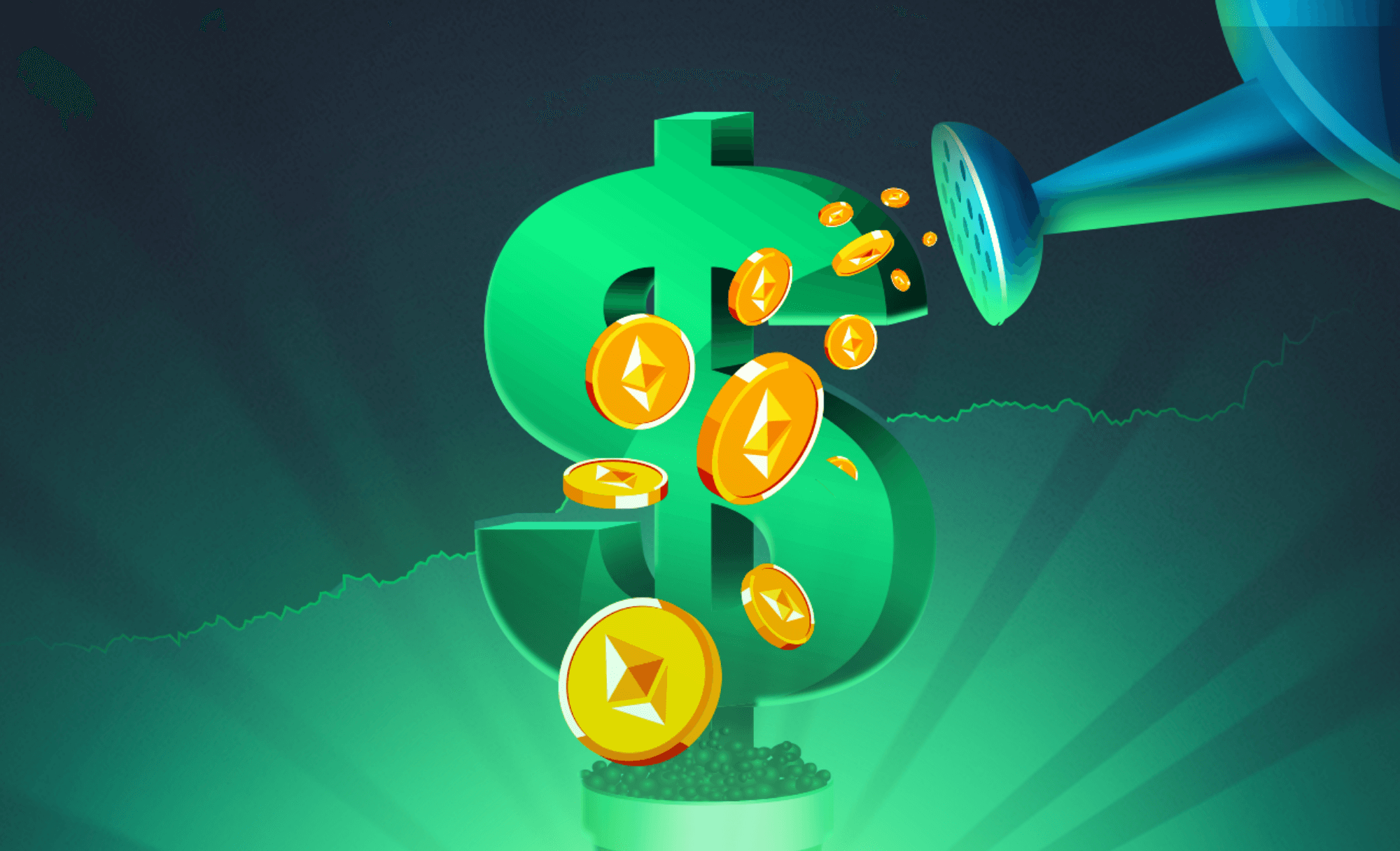Learn more about staking & yield farming - including where to stake, which cryptos to stake, and how yields are paid!
In one of our first few articles about the blockchain - we talked about staking and how it involves setting aside a certain amount of cryptocurrency to have it perform work and validate transactions on a proof-of-stake blockchain. In return, you would receive a yield that can be paid out in the same cryptocurrency, or even multiple cryptocurrencies. To recap:
- People who participate in full-node staking are called validators. Anyone can technically be a validator, because it is possible to run using normal hardware. Unlike proof-of-work miners who are required to run complex computations, validators don't need insane processing power. This is one of the reasons why proof-of-stake is highly scalable.
- To volunteer as a validator, you must stake a certain amount of a cryptocurrency to qualify. For example, Ethereum requires that you stake at least 32 ETH (their currency) to qualify.
- Users who do not have enough crypto to qualify as a standalone validator can opt to join a staking pool. They will combine their assets with other users and earn a percentage of the total rewards.
- You do NOT lose or move your crypto to a different location when it is staked - you're only giving permission for it to be "put to work." Oftentimes, the condition for staking is that you lock-in those funds - meaning you cannot withdraw it for a set period of time.
- Your computer processor is used to verify transactions by creating new blocks, or deciding with other validators that a new block looks legitimate - in a process known as attestation.
- The reward for staking is paid as a yield - similar to an interest payment, except you're getting additional amounts of that crypto.
But not every blockchain functions this way when it comes to staking. We'll talk about this more in later sections!
Where can I stake my crypto?
Most exchanges will allow you to stake your crypto on their platform. Binance, Crypto.com, Kraken, and eToro are some of the most popular platforms for staking. However, they offer different rates on their assets depending on whether you opt for locked staking or restriction-free staking.
In locked staking, you must agree to meet a certain holding period before you can be eligible to receive a yield. This period can last weeks, months, or in the extreme case of ETH 2.0 - even years! However, exchanges will pay higher yields as a tradeoff for the increased risk. At Finblox, we have an alternative solution to staking that offers the highest yields without forcing our users to lock-in their funds. Locking in your assets can create a variety of problems when it comes to liquidity, avoiding market risk (drops in the value of your asset), and accessing emergency funds when needed.
Wallet staking allows you to earn staking yields while your crypto is stored in an online wallet. This is slightly more secure than exchange staking and allows you to maintain custody of your own assets. However, those funds should not leave the wallet for any reason in order for you to qualify.
Cold staking allows you to earn yield on your crypto while it is stored in an offline wallet - protecting it from most cybersecurity threats. This is much more uncommon method of staking, and not widely supported. The biggest risk with cold staking is that you need to store your assets on a hardware wallet, and if you lose that - your funds are gone forever.
Liquidity staking is a more complex form of staking that requires you to lock-in your assets to support the operations of a liquidity pool on a decentralized exchange. Users who do this become liquidity providers (LPs), and receive a percentage cut from all trades that are executed using this liquidity pool. On top of that, they will also be paid tokens as yield from the decentralized exchange - giving them two potential sources of income! This provides the basis for yield farming.

What are some of the top cryptos to stake?
- Ethereum (ETH) - Staking ETH can be performed directly on an exchange or in a private crypto wallet such as Metamask. Remember that to become a validator, you must be prepared to lock up at least 32 ETH. The good news is that there are almost 300,000 full validators, and this number is growing every year! However, the bad news is that the holding period is exceptionally long. Ethereum has announced that they do not plan to make unstaking available for another 1-2 years, until the "merge of Mainnet with the beacon chain" update completes.
- Polkadot (DOT) - To stake DOT as a validator, you must have a minimum of 5,000 DOT and apply for the Thousand Validators program in both Kusama and Polkadot. This is to ensure that you are properly trained and reputable on-chain in both the Kusama and DOT networks. However, you can also stake DOT as a nominator - a person who votes for validators and receives rewards when their validator is elected. DOT has a 28-day lockup period.
- Solana (SOL) - There are no requirements (beyond hardware) to become a Solana validator, and there nearly 1,500 validators on the network as of today. However, staking SOL requires a supported wallet such as Phantom, Sollet, or Solflare. Most people choose to become delegators, and contribute their funds towards a validator pool. SOL has a minimum lock-in period of 1 epoch, which is equivalent to roughly 2 days.
- Cosmos (ATOM) - Becoming a validator in Cosmos requires ranking in the top 150 holders of staked ATOM. If you fall in the rankings, you will be stripped of your validator privileges. ATOM can be staked directly on some major exchanges and a few private wallets such as Atomic, Ledger, and Trust. The lock-in period for ATOM is 3 weeks.
- Near Protocol (NEAR) - There are currently 100 seats for NEAR validators, and you must have a stake that is at least as large as the current seat price (roughly 112,690 NEAR) to qualify. Since this is unlikely, you'll probably need to apply as a delegator. NEAR has a minimum lock-in period of 2-3 epochs (4-6 days), which are required to "unbond" the tokens.
- Stablecoins (USDC, USDT, etc.) - You can stake stablecoins on nearly any major exchange and wallet for no requirements; however the yields are relatively low due to the stability of the asset. Reward is usually directly proportional to risk when it comes to yield.

How are staking yields paid out?
There are a few things to consider when choosing which crypto and platform to stake with: the capital requirement for staking, the holding period, how big the yield amount is, what form of payment the yield comes in, and the scheduled distribution of the yield.
Capital requirement simply refers to how much of that asset is needed to qualify for staking. For example, Ethereum validation requires 32 ETH (roughly 96,000 dollars) which would put it squarely out of reach for most people. If the capital requirement far exceeds your potential rewards and would lock up a good portion of your total net worth - it might be reason to reconsider.
The same can be said of the holding period, especially during times of extreme volatility. The crypto market can skyrocket and turn upside-down in the blink of an eye, and being locked-in would prevent you from getting out of a bad position - or reinvesting those funds to get in a good position.
Yield amount is straightforward, and should be factored in when it comes to your risk-vs-reward ratio. But, you would be mistaken if you think yields are only paid out in the form of the token that you staked! Sometimes, you can receive an entirely different cryptocurrency - or even be paid with two types of tokens. This happens frequently when you decide to stake as a liquidity provider.
Finally, you'll need to consider the scheduled distribution of the yield - when and how often the yield gets paid to you. Your platform might pay you twice a week, or once a month. This restricts you when it comes to un-staking and withdrawing your assets, as doing it too early will result in the loss of a potential reward!
What is yield farming?
Yield farming can be thought of as a super advanced yield-generating technique that combines DeFi borrowing and lending, staking, and liquidity pools. To be honest, there is no clear guide or strategy on the internet that can fully explain the amount of research and complexity that goes into yield farming. However, we'll try to break it down as simple as possible:
- All yield farming happens on a decentralized exchange (DEX). These are completely unsupervised marketplaces where people can borrow, lend, and swap tokens for one another. You might hear the term automated market maker (AMM) thrown around - this is pretty much the same thing, and refers to the permissionless program used to regulate the prices of assets and execute smart contracts on the DEX.
- One way to earn rewards on a DEX is to stake two types of assets (a trading pair) to a liquidity pool, making you a liquidity provider. You'll receive yield in the form of liquidity pool tokens (LP tokens) based on the amount you contributed. You can also collect a percentage of transaction fees in that trading pair when they're swapped, giving two sources of income!
- The second way to earn rewards is to lend your assets directly to another user, which pays you interest.
- In either case, rewards are paid in the form of one or multiple tokens. The idea is to take these tokens and "reinvest" them into a similar strategy, creating an endless loop of yield-generating possibilities.

So why is borrowing part of yield farming?
People usually borrow crypto because they want additional funds to stake - which would give them greater yields. They have to put up another crypto as collateral in order to borrow these assets, and will lose that collateral if A) they fail to repay the loan, B) have the value of their loan exceed a certain ratio with the collateral, or C) have the value of their collateral fall below a certain ratio with the loan. If one of these conditions are triggered, the user will be liquidated - that is, they'll be forced to repay the value of that loan plus any liabilities owed. This is devastating because it can collapse your entire "chain" of yield farming, in a domino effect.
On the plus side, the crypto used as collateral can still appreciate in value for the user while it is being held. The user can potentially earn on both their collateral and the newly borrowed funds.
Tricky, isn't it? This fine act of balancing involves price risk. In a nutshell, you better hope that the value of your collateral stays the same in proportion to the borrowed crypto - or increases in value!
But not all borrowed crypto gets staked into a liquidity pool. Some people will actually opt to lend the borrowed crypto out again - because the lending interest rate is higher than the interest rate charged to borrow it! This can be considered a form of arbitrage, and seasoned yield farmers will frequently hop between different platforms in search of the best rates.
The Takeaway:
Staking can be an attractive option for earning passive income on your assets, but needs to be considered from a risk/reward perspective when it comes to minimum capital requirements and restrictive holding periods. Yield-farming can also be incredibly lucrative, but holds numerous price differential risks due to two or more assets being involved - and a potentially complicated chain of yield-generating sources that can be impacted.
Here at Finblox, we make things easy by having no minimums, no lock-ins, and no limits on when you can withdraw. We also compound and pay our rewards daily - making us the ideal solution for those who are looking for the best blend of safety, reliability, and earning potential. Let us handle the strategies for generating yields, so that you don't have to do the research or carry any of the risks!
Thanks for reading! Please subscribe if you haven't already, and stay tuned to learn more about cryptocurrency market cycles, and how changes in traditional stock markets might affect crypto investors.
This content is provided for informational purposes only, and should not be relied upon as legal, business, investment, or tax advice. You should consult your own advisers as to those matters. Charts, graphs and references to any digital assets are for informational and illustrative purposes only.



